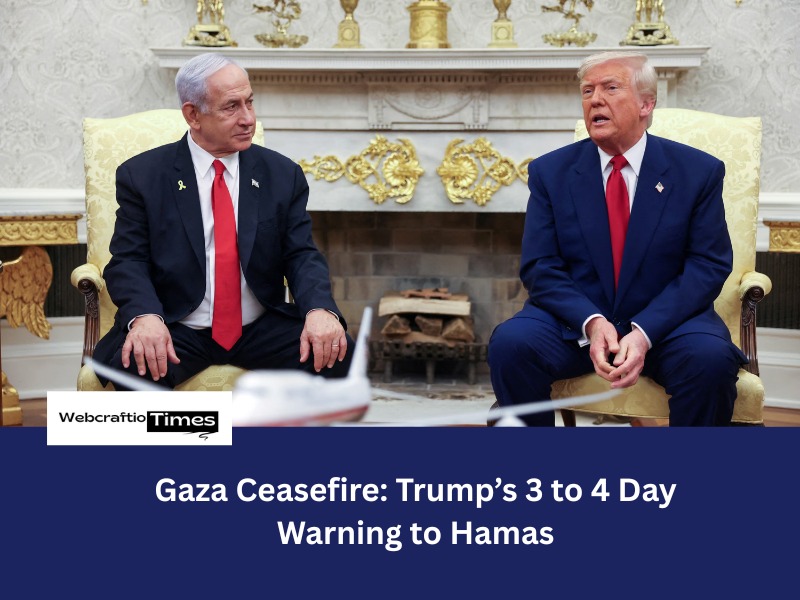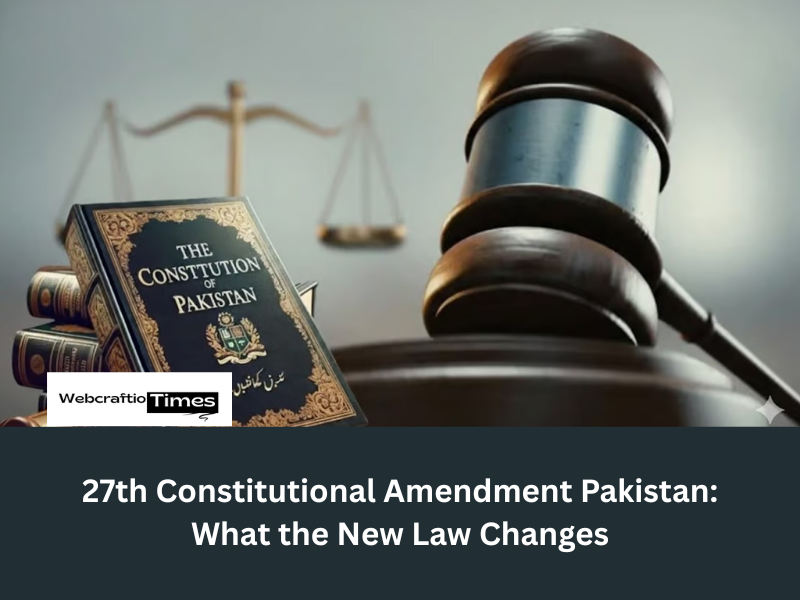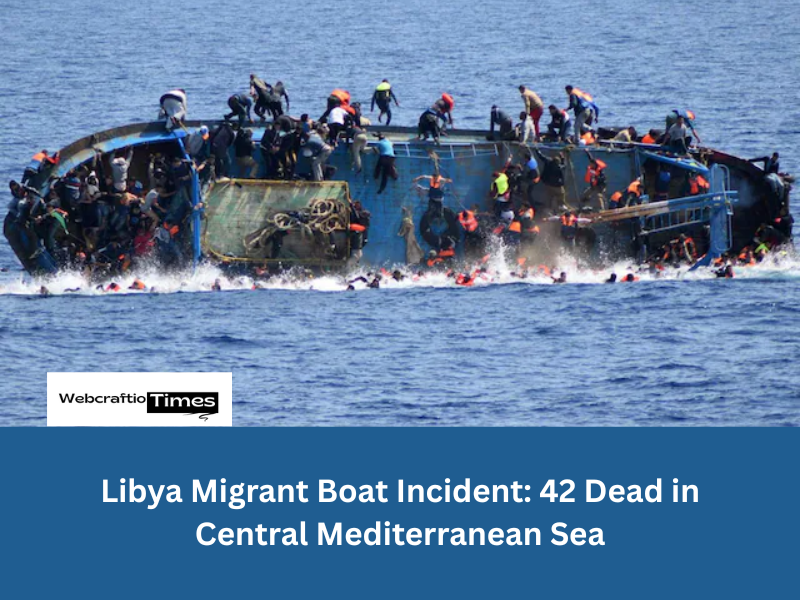In today’s world full of interesting geopolitical events, few statements have created as much noise as Donald Trump’s recent warning to Hamas. As we know the war in Gaza is already on its peak. Its causing many innocent life losses and so much political tension.Trump said that Hamas has only three or four days to reply to a 20-point peace and rebuilding plan of Gaza.
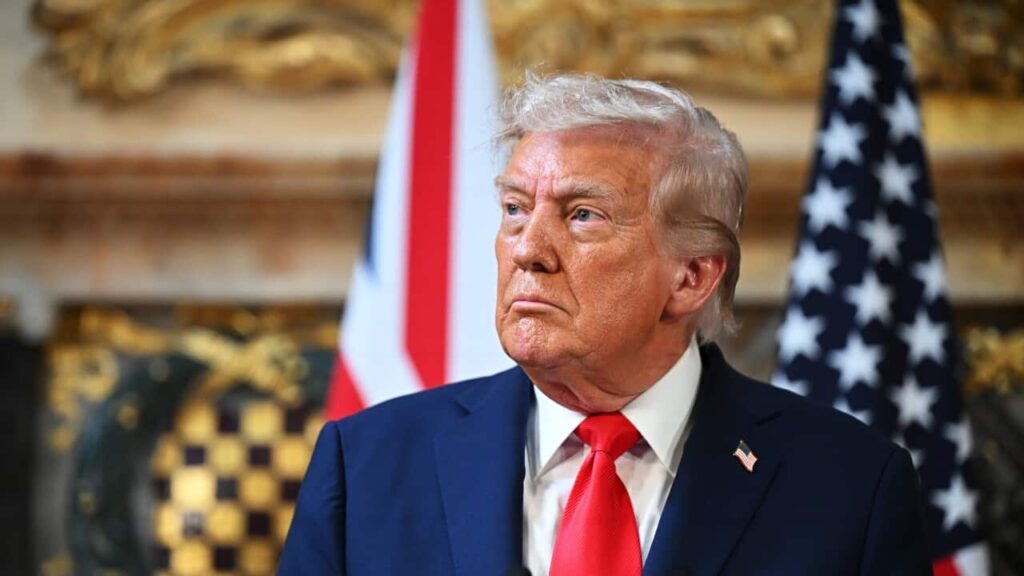
This warning is not just a normal warning. The main mission of Trump behind this is he wants a quick response for Hamas. The plan, which Trump announced alongside Israeli Prime Minister Benjamin Netanyahu, offers Gaza major economic benefits and development. But in return, Hamas would have to give up much of its current political and military power.
This short discussion raised many questions, will now Gaza become peaceful forever or will it be just temporary peace ? Or will it create more conflicts instead of peace ?
In this article, we will look at Trump’s proposal, look at the heavy pressure on Hamas. How different countries are reacting, and explore the tough road ahead for lasting peace in Gaza.
Understanding the Trump Plan: The 20-Point for Peace in Gaza
At the center of Trump’s short deadline is a 20-point plan, which he calls a roadmap to end the Gaza conflict and bring peace and progress to the region. On paper, the plan looks very ambitious, offering the hope of stability and better living conditions for the people of Gaza.
But the proposal also comes with tough conditions. Some of these demands directly threaten Hamas’s position as both a political authority and a military force. In other words, accepting this deal could mean the end of Hamas as we know it.
To understand the weight of this moment, it’s important to look closely at the key points of Trump’s plan. Only then can we see how big the choice in front of Hamas really is.
1. Immediate Ceasefire & Hostage Release
The first step in Trump’s plan is a complete stop to all war in Gaza. But this ceasefire comes with a strict condition and the condition is Hamas must release all Israeli hostages within 72 hours, and Israel must publicly agree to the deal.
This puts heavy pressure on Hamas, because those hostages are its strongest bargaining tool. In exchange, Israel would begin releasing some Palestinian prisoners, but the exact number and names have not been decided yet and would depend on further talks.
This plan is meant to calm the situation quickly and create a small base of trust between both sides. Even if that trust is very fragile
Read This : France and More: Why Are Recognized Western States Recognizing Palestine Also?
2. Hamas Must Give Up
This is the most toughest and most controversial part of the whole plan. It demands that Hamas, along with all other armed groups in Gaza, must completely give up their weapons and military power.They will give up for forever and never fight with Israel again.

The plan also makes it clear that Hamas would no longer have any role in running Gaza’s government. In short, this would mean dismantling Hamas’s military network and removing its political authority altogether.
For Hamas, agreeing to this condition would mean giving up the everything.
3. Temporary Neutral Government
Since Hamas would no longer be in charge. The plan suggests creating a temporary government made up of Palestinian who do not have any relations with Hamas. Their main job would be to handle the early stages of rebuilding Gaza and running basic governance.
This government would not be political. Instead, it would work under the supervision of an international “Board of Peace.” President Trump has even said he plans to personally lead this board. Its showing that the U.S. wants to take a direct role in Gaza’s immediate future.
The idea is to have a neutral, practical administration focused only on peace and reconstruction, not politics or party agendas.
4. Massive Economic Development & Reconstruction
A cornerstone of the Trump plan is a colossal economic development and reconstruction initiative for Gaza. Often likened to a “Marshall Plan,” this ambitious segment aims to rebuild the devastated infrastructure, create jobs, and improve living conditions for Gaza’s population. It promises billions in international aid and investment, transforming Gaza from a besieged territory into a hub of economic activity. The lure of prosperity is a powerful incentive, designed to appeal to the war-weary population and underscore the benefits of peace over continued conflict.
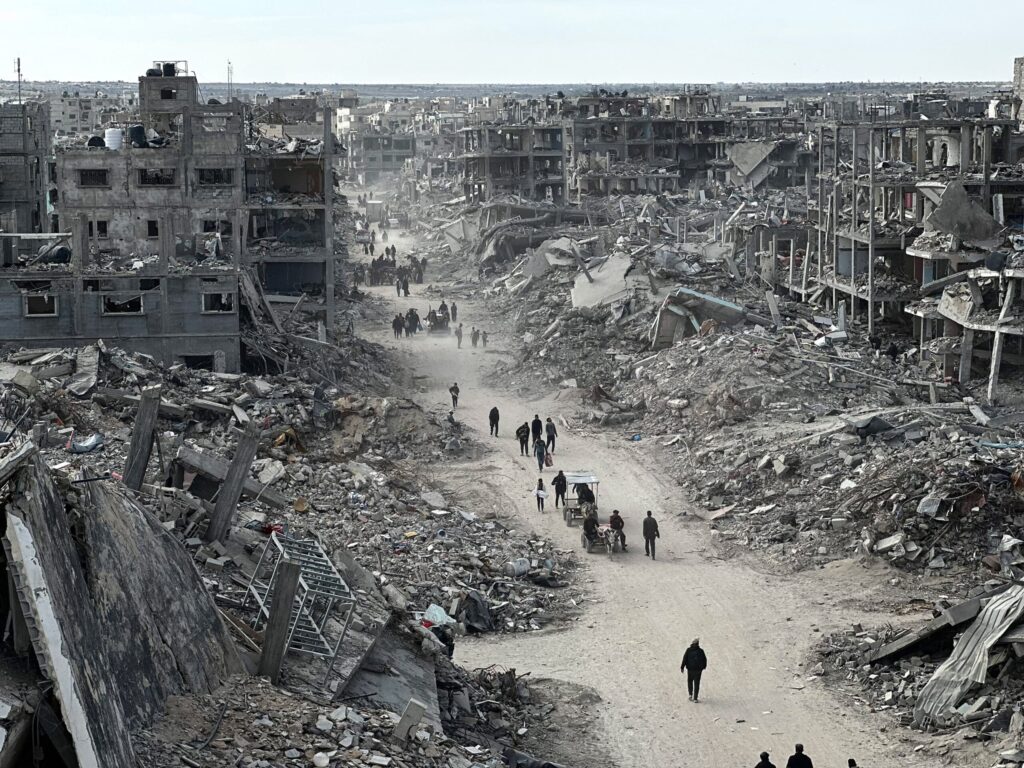
5. Enhanced Security Arrangements
Beyond disarmament, the plan outlines new security arrangements for Gaza. While specific details are sparse. It implies an international monitoring force or a new Palestinian security apparatus that is not affiliated with militant groups. The goal is to prevent any resurgence of armed factions and ensure Israel’s long-term security.
6. The Elephant in the Room: Palestinian Statehood
A critical omission from the publicly detailed points of the Trump plan is a clear, explicit pathway to a sovereign Palestinian state based on the 1967 borders with East Jerusalem as its capital. While the proposal alludes to a future “path to statehood,” it avoids the specific framework long championed by the international community. This ambiguity, and perceived deviation from established international consensus, remains a significant point of contention for many Palestinians and their supporters, complicating any potential acceptance of the broader plan.
Hamas at a Crossroads: Weighing the Risks of Accepting or Rejecting the Deal
The “three or four days” deadline has plunged Hamas into one of its most critical existential dilemmas. The group faces an unenviable choice, with profound and potentially devastating consequences regardless of its decision. The pressures are immense, both from within its ranks and from external forces.
Internal Divisions and Factional Pressures
Hamas is not a monolithic entity. It comprises various wings, including political leaders, military commanders, and diaspora figures, each with differing priorities and ideologies. The proposal’s demand for complete disarmament and demilitarization strikes at the core of the military wing’s identity and power. Accepting these terms could trigger significant internal backlash, potentially fracturing the movement or leading to a revolt from hardliners who view armed resistance as non-negotiable. Other Palestinian factions, such as Islamic Jihad, also exert pressure, advocating for continued resistance and warning against any concessions that undermine Palestinian rights.
Read More : Saudi Arabia-Pakistan Defence Pact: A Game-Changer for Regional Geopolitics
External Pressure and Regional Dynamics
Hamas is not immune to regional pressure. Key mediators like Egypt and Qatar, who often serve as conduits between Hamas and the international community, are likely pressing the group to seriously consider the offer, fearing further regional instability and humanitarian catastrophe if the conflict continues unabated. Many Arab and Muslim-majority countries, eager for an end to the conflict and the promise of stability, are also subtly or overtly pushing for acceptance, recognizing the potential economic benefits for Gaza and the wider region.
The Consequences of Rejection
President Trump’s stark warning that Hamas would “pay in hell” if it rejects the plan underscores the severe repercussions. A rejection could lead to:
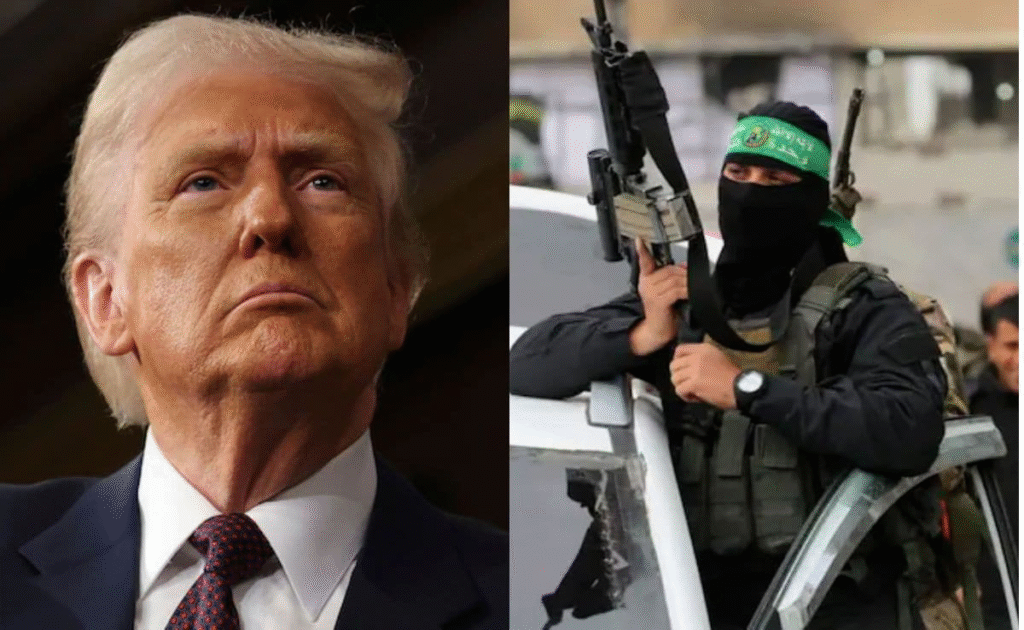
- Continued and Intensified Conflict: Israel, with strong U.S. backing, would likely escalate military operations aimed at dismantling Hamas’s capabilities, potentially leading to even greater civilian casualties and destruction in Gaza.
- International Isolation: Rejecting a plan supported by a broad international coalition could further isolate Hamas, cutting off potential avenues for aid and political support.
- Worsening Humanitarian Crisis: The already dire humanitarian situation in Gaza would almost certainly deteriorate further, leading to increased suffering for the 2.3 million Palestinians trapped in the enclave.
- Loss of Future Leverage: Prolonged conflict could weaken Hamas to a point where its ability to negotiate any future terms is severely diminished.
The Consequences of Acceptance (for Hamas): While offering a path to end the immediate conflict and secure massive reconstruction, acceptance comes at a steep price for Hamas:
- Loss of Political Power and Governance: Relinquishing control of Gaza means ceding its most significant political achievement since its 2007 takeover.
- Disarmament: This is an ideological and existential challenge. Giving up its military wing means abandoning its primary means of “resistance” and perceived deterrent against Israeli actions.
- Backlash from Hardliners: Elements within Hamas and allied groups would view acceptance as a betrayal of the Palestinian cause and a surrender to Israeli and American demands.
Why the Delay? Strategic Calculation or Genuine Deliberation? Hamas’s review period isn’t merely about reading a document. It’s a complex process of internal deliberation, consultations with allies, and strategic calculation. They might be using the time to seek clarifications, negotiate minor concessions, or simply to weigh the political costs of each path. They also understand that this decision will shape their future for decades to come, not just for the next “three or four days.”
Global Echoes: How the World is Reacting to Trump’s Gaza Peace Initiative
The announcement of Trump’s deadline and the underlying peace proposal has naturally elicited a spectrum of reactions from across the globe, reflecting the diverse interests and geopolitical alignments at play. From cautious optimism to outright skepticism, the world is watching with bated breath.
Strong Support from Arab and Muslim-Majority Countries
Notably, the proposal has garnered significant backing from a number of influential Arab and Muslim-majority countries, including Saudi Arabia, Qatar, Turkey, and Egypt. Their motivations are multifaceted:
- Regional Stability: A stable Gaza is seen as crucial for broader regional security, reducing the risk of spillover conflicts.
- Economic Opportunity: The promise of massive reconstruction and economic development for Gaza, potentially spilling into regional trade, is a powerful incentive.
- Humanitarian Concerns: These nations are deeply concerned about the humanitarian crisis in Gaza and see an end to hostilities as paramount.
- Political Pragmatism: For some, it represents a path to normalize relations or strengthen existing ties with Israel under U.S. mediation.
Cautious Optimism from European Nations
European powers have largely expressed cautious optimism, while reiterating their long-standing commitment to a two-state solution based on international law. While they welcome any initiative that could lead to peace, some have voiced concerns about the lack of an explicit pathway to Palestinian statehood within the current framework and the potential for unilateral actions to undermine future negotiations. They generally emphasize the need for humanitarian aid and adherence to international humanitarian law throughout the process.
Israeli Stance and Domestic Implications
Israeli Prime Minister Benjamin Netanyahu has publicly aligned himself with the Trump proposal, viewing it as a significant diplomatic achievement and a step towards ensuring Israel’s security. The plan’s emphasis on Hamas’s disarmament and the absence of an immediate, full Palestinian state resonates with hardline elements within his government and coalition. However, there are also domestic considerations regarding the precise terms of a prisoner exchange and the management of any transitional phase. For Israel, the core appeal lies in the potential for a demilitarized Gaza and the removal of Hamas from power.
Skepticism and Criticism: Despite the widespread support, the plan has also faced skepticism and outright criticism from certain quarters. Some Palestinian factions, outside of Hamas, have criticized the plan for not adequately addressing Palestinian national aspirations, particularly regarding statehood and the status of Jerusalem. Some international human rights organizations and segments of the international community have also raised concerns about the unilateral nature of the proposal, arguing that true peace requires a process negotiated between all parties, ensuring self-determination for Palestinians. The absence of direct Palestinian input in crafting the initial proposal is seen by some as a fundamental flaw.
Beyond the Deadline: What Lies Ahead for Peace in Gaza?
As the “three or four days” deadline looms large, the gaze extends beyond the immediate decision point to the complex and uncertain road ahead. The outcome of Hamas’s deliberations will not be an end, but rather a profound new beginning, for better or for worse.
Potential Scenarios Post-Deadline
- Hamas Accepts (with or without minor conditions): This scenario would trigger the immediate implementation of the ceasefire, hostage release, and the establishment of the transitional government. It would usher in an era of unprecedented international oversight and massive reconstruction efforts, fundamentally altering Gaza’s future trajectory.
- Hamas Rejects: A clear rejection would likely lead to a significant escalation of the conflict. Israel, backed by the U.S., would feel emboldened to pursue its objectives more aggressively, potentially initiating further extensive military operations aimed at dismantling Hamas’s remaining capabilities. The humanitarian crisis would deepen, and international efforts might shift from peace proposals to emergency aid and crisis management.
- Partial Acceptance or Delayed Response: Hamas might offer a conditional acceptance, seeking further negotiations on specific points, particularly regarding disarmament or the terms of the transitional government. This could lead to a new round of intense diplomatic efforts and a modified timeline.
Long-Term Challenges to Sustainable Peace
Even if Hamas accepts the proposal, the path to lasting peace in Gaza is fraught with formidable challenges:
- Rebuilding Trust: Decades of conflict, loss, and resentment have created deep wells of distrust between Israelis and Palestinians. Rebuilding trust will be a generational endeavor requiring consistent effort and tangible results.
- Political Integration: What becomes of the millions of Palestinians in Gaza in the long term? How will their political aspirations be addressed in a post-Hamas era? The absence of a clear and immediate path to statehood remains a significant hurdle.
- Economic Viability: While massive aid is promised, ensuring Gaza’s long-term economic viability and self-sufficiency, free from blockades and restrictions, will be crucial to prevent future grievances.
- Security for All: Establishing a robust security framework that ensures Israel’s safety while also protecting the rights and security of Palestinians in Gaza will be a delicate balance.
The Indispensable Role of the International Community: Regardless of Hamas’s immediate decision, the international community will play an indispensable role. Continued mediation, sustained humanitarian aid, support for reconstruction efforts, and diligent oversight of any agreements will be critical. The “Board of Peace” envisioned by Trump, if formed, would need broad international buy-in and legitimacy to succeed.
The next few days are pivotal for Gaza. President Trump’s deadline has forced an urgent reckoning, potentially pushing the region towards a moment of profound transformation. Whether this moment culminates in a fragile but hopeful peace, or descends into a more entrenched and bitter conflict, rests heavily on the decision made in Gaza within this narrow window of time. The stakes could not be higher, and the world holds its breath.
5 FAQs on Trump’s Gaza Peace Proposal
Here are five frequently asked questions with short, relevant answers regarding Donald Trump’s deadline for Hamas to respond to the Gaza peace proposal:
1. What is the deadline Trump gave Hamas?
President Trump publicly stated that Hamas has approximately “three or four days” to accept or reject the 20-point peace and reconstruction proposal for Gaza.
2. What are the most controversial demands in the peace plan for Hamas?
The most controversial demands are the requirements for the complete disarmament and demilitarization of Hamas and the stipulation that the group will have no future role in governing Gaza.
3. What are the consequences if Hamas rejects the proposal?
If Hamas rejects the proposal, President Trump warned that the militant group would face severe consequences, including intensified military action from Israel, which has U.S. backing to “finish the job.”
4. What is the major incentive offered to Gaza in the proposal?
The major incentive is a massive economic development and reconstruction plan—often described as a “Marshall Plan”—aimed at rebuilding the war-torn territory and creating prosperity for the Palestinian people in Gaza.
5. Has Hamas officially responded to the deadline?
As of the latest reports, Hamas has not officially accepted or rejected the plan. Officials have stated they are reviewing the proposal internally and consulting with other Palestinian factions before issuing a formal response to the mediators.

